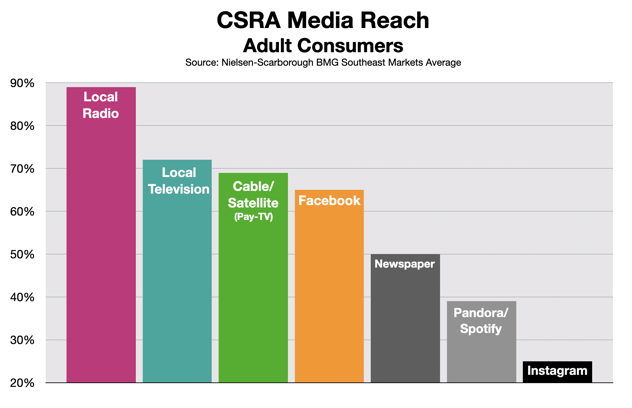 Car radios came to the Central Savannah River Area in June of 1930. For just $120, about $1200 in present dollars, local drivers could install these early mobile devices into their Fords, Studebakers, Packards, and DeSotos,
Car radios came to the Central Savannah River Area in June of 1930. For just $120, about $1200 in present dollars, local drivers could install these early mobile devices into their Fords, Studebakers, Packards, and DeSotos,
The first car radios were built by the Galvin Manufacturing Company of Chicago. They named their invention, and eventually their company, Motorola.
Today, more than 357,000 car radios fill ears of area drivers with music, news, sports, and information. As a result, local radio reaches more consumers than all other media.
In a typical pre-COVID-19 week, according to Nielsen, 89% of adult consumers would tune-in to an Augusta radio station. This is significantly more than were reached by local TV, cable, social media, newspaper, or streaming media sites Pandora and Spotify.
In early April, however, the Governors of Georgia and South Carolina shut down their states to slow the spread of the Coronavirus. Overnight, traffic on Augusta area roads plummeted to 55% of pre-pandemic levels, according to the Apple Mobility index.
Although the shutdown kept cars off the road for several weeks, Nielsen reports that radio listening did not go away. It just shifted indoors. As mobility has begun to exceed pre-pandemic levels, though, out-of-home listening is surging back to typical levels.
In 1930, Motorolas were the only option for in-car entertainment. Today, though, the dashboards of CSRA drivers are dense with choices. Local radio, according to a 2020 study by Edison Research, remains, by far, the most used of these options.
Radio's return to the roads is great news for CSRA small business owners who depend on the medium for advertising its goods and services.

According to an article published by WARC, a company that collaborates with more than 50 respected marketing organizations, including the Advertising Research Foundation and the Association of National Advertisers, reaching consumers in car has a powerful effect on buying behavior.
"Radio ads heard in the car on the way to the store have a significant effect on purchasing intentions according to new research on fast-moving consumer goods (FMCG) advertising," says WARC.
The study, conducted by Touchpoint indicate that these radio commercials heard in the car increased purchased intent among loyal customers by 38%.
Purchase intent among non-loyal brand-customers rose 39% among those exposed to in-car radio commercials.
More Advertising Advice for CSRA Small Business Owners
- Advertising On Augusta Radio: What Consumers Want To Hear
- Advertising In Augusta: Consumers Pay More For Sustainable
- CSRA Furniture Retailers Expect A Post-Pandemic Rebound
- Political Advertising On Augusta Radio Sways Voters
- Facebook Advertising: Why CSRA Business Owners May Be Pausing
- Why CSRA Banks & Credit Unions Need To Advertise Now
- Real Estate Advertising In The CSRA: Starter Home Sales Are Thriving







